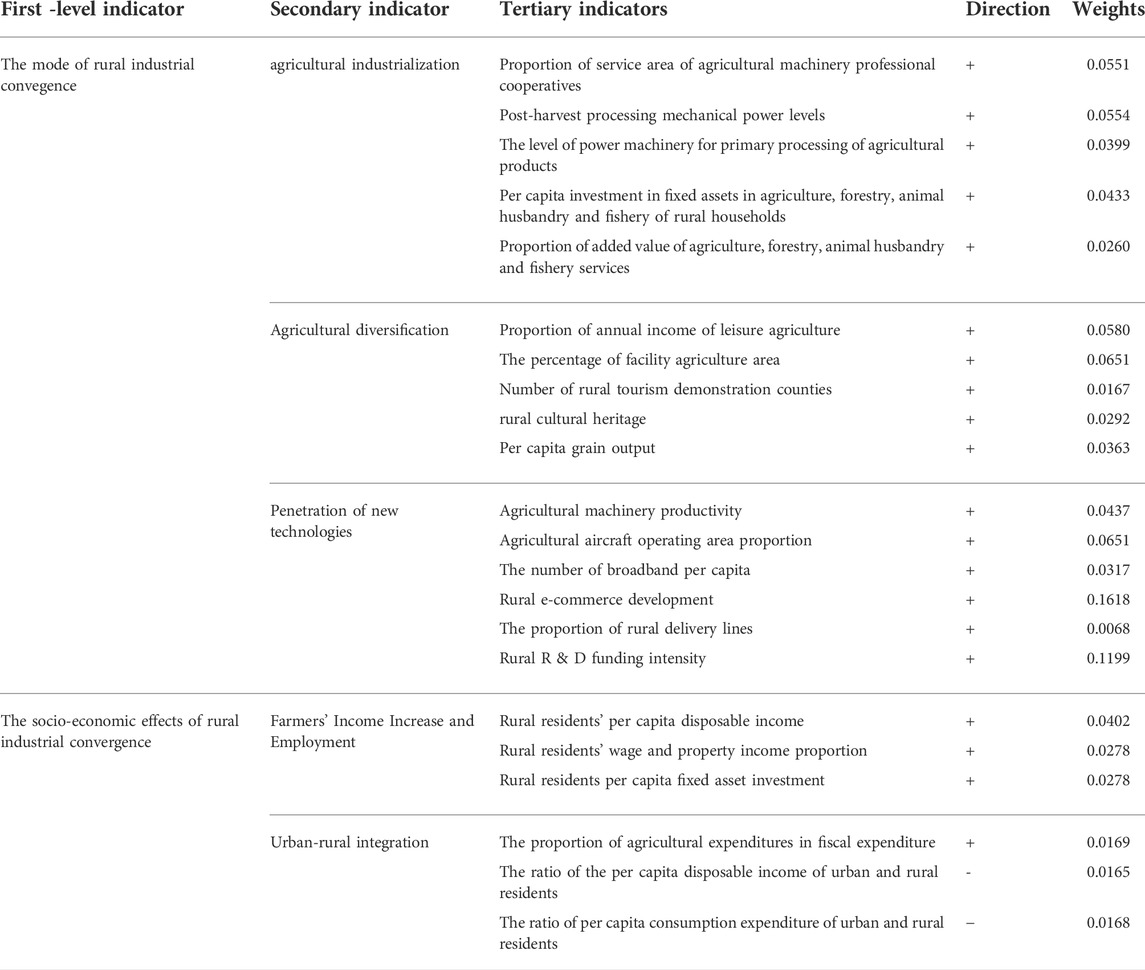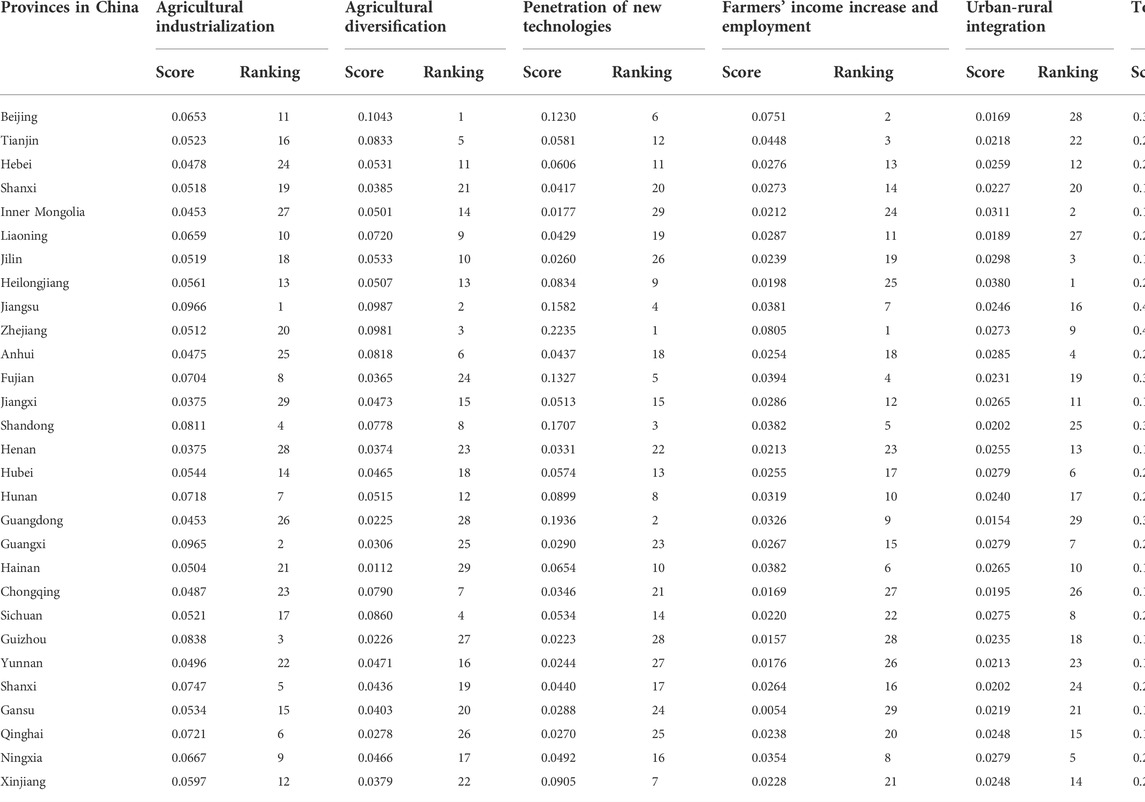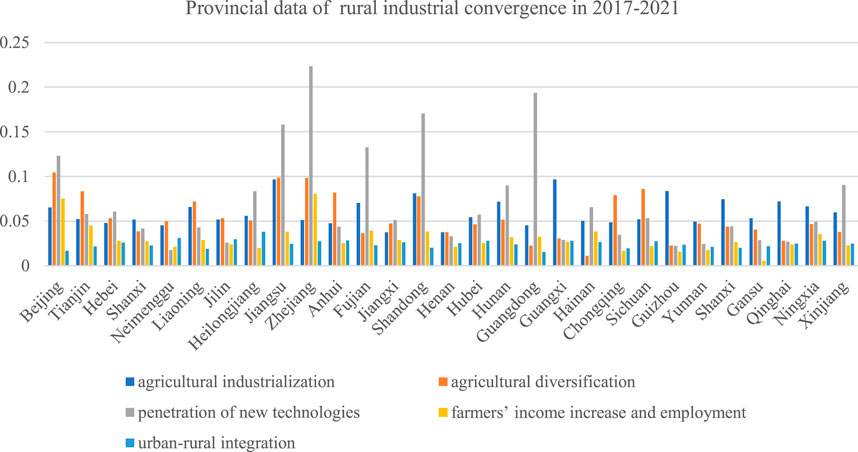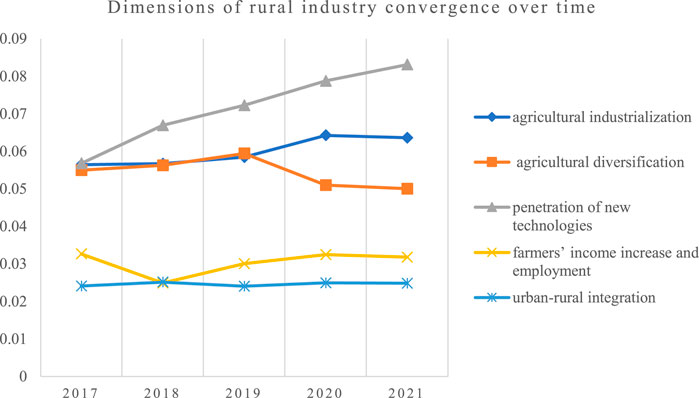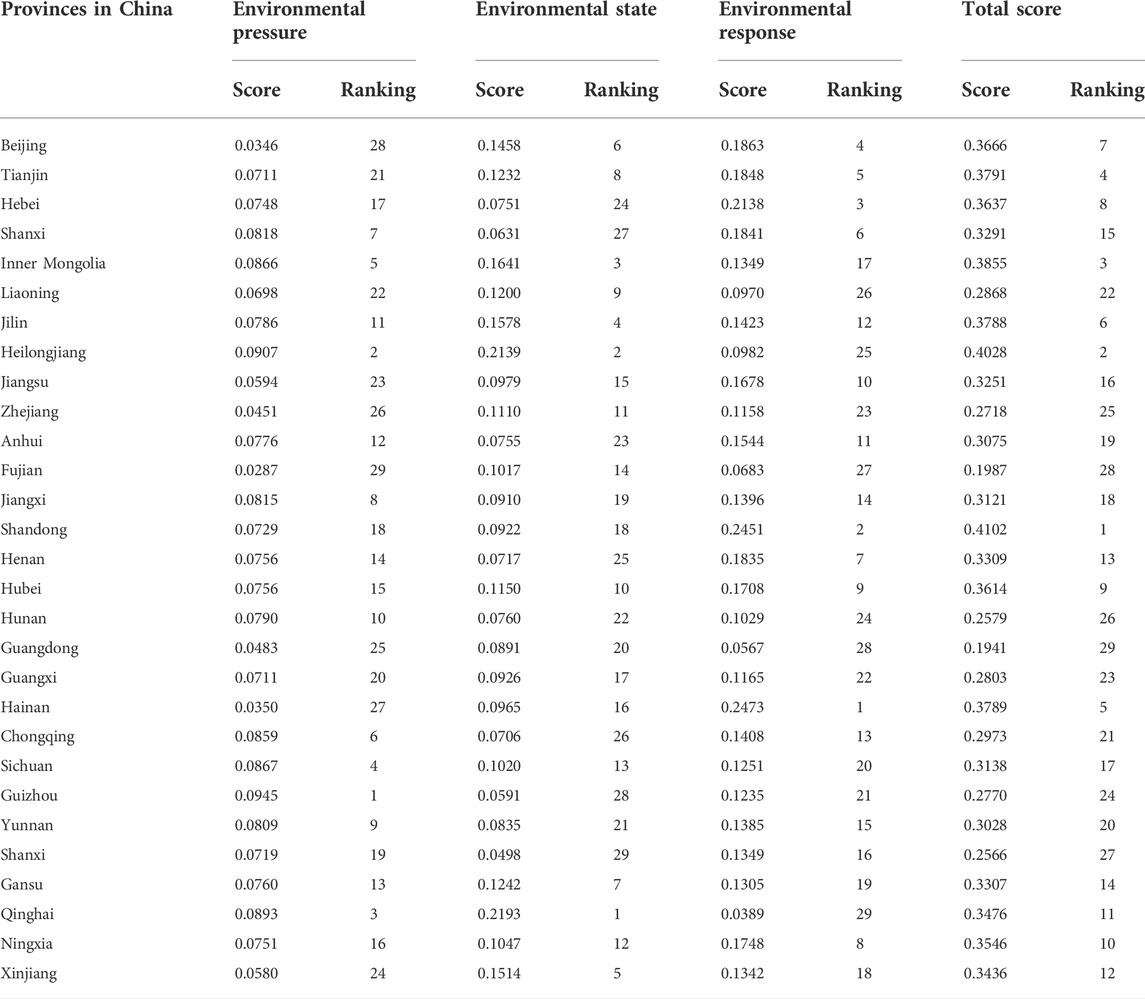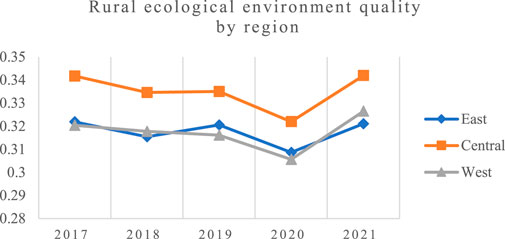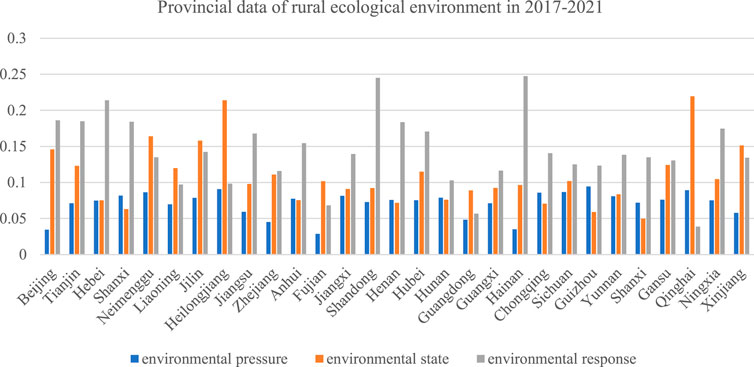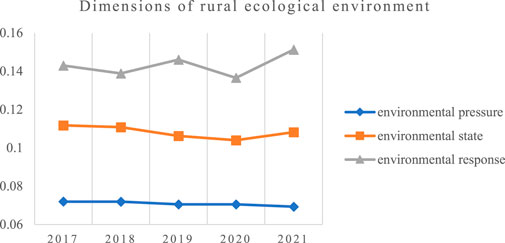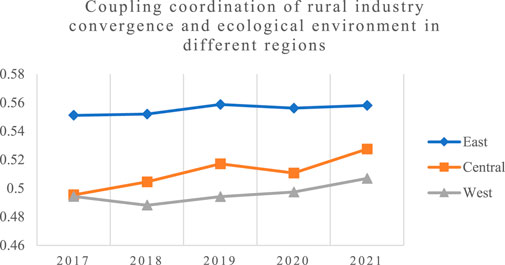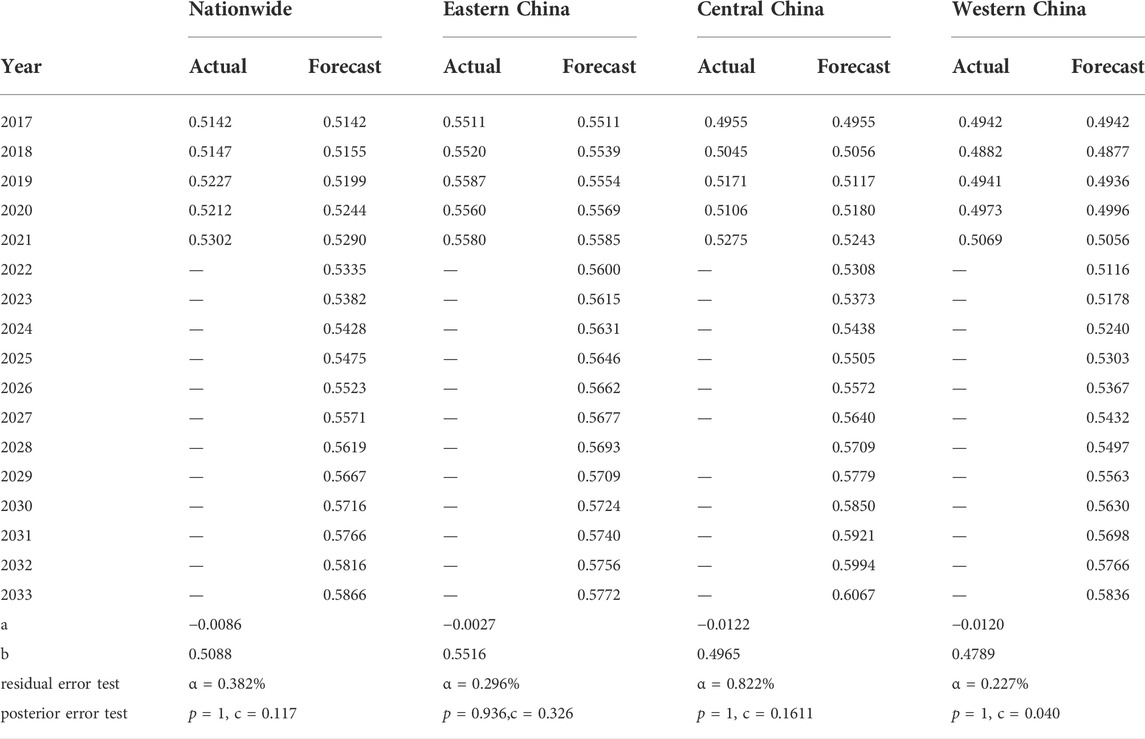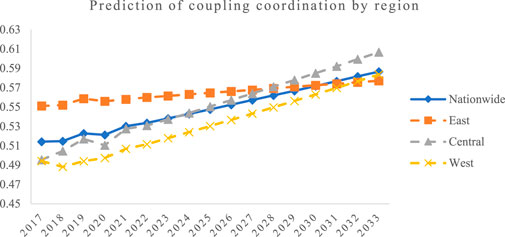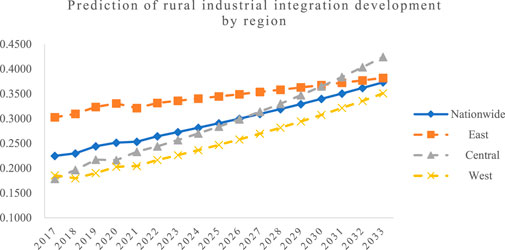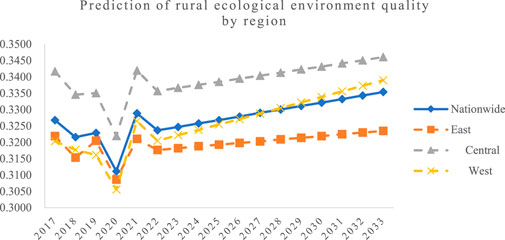- Business School, NanJing XiaoZhuang University, Nanjing, China
Coordination of rural industrial convergence and ecological environment is an important issue in rural social and economic development. This study aims to introduce a comprehensive evaluation index system and construct an integrated approach to evaluate and predict the coupling coordination between rural industrial convergence and ecological environment. Firstly, an index system including 40 indexes is developed for evaluating the two subsystems, and then entropy weight method is applied to determine the weights. Finally, a coupling coordination model and a grey prediction model are developed using provincial panel data from 2017 to 2021 for 29 provinces in China. There are three main findings: 1) penetration of new technologies and agricultural industrialization are the main driving factors of rural industrial convergence. In the three dimensions of ecological environment, environmental pressure has been the smallest contributor, implying that environmental pressure in rural China still needs attention in the next decade. 2) the coupling coordination between rural industrial convergence and ecological environment shows a fluctuating upward trend in China during the studied period and will continue to rise in the next 12 years. Among the 29 provinces studied, only 4 eastern developed provinces have reached primary coordination. The forecast data suggests that coordination with ecological environment will promote the development of rural industrial convergence. 3) the spatial differences of the coupling coordination are related to the level of economic and cultural development, application of agricultural technology, convergence of information technology, energy consumption structure and stock of natural resources. In conclusion, the research develops a rational index system and an effective approach to measure and predict the coupling coordination between rural industrial convergence and ecological environment, providing a theoretical basis for the environmental considerations in the rural industrial convergence policy-making.
1. Introduction
China’s agriculture has undergone two important changes. The first one is to deepen the whole industrial chain from single production to processing, circulation, sales, and brand building of agricultural products. The second is to transform the single production function to the multi-functions of leisure, tourism, ecology, culture, creativity, health care, etc. Since 2015, the central government of China has annually issued relevant documents and policies to promote the rural industrial convergence. All provinces and cities regard industrial convergence as an important means to accelerate the rural development and has achieved remarkable results.
However, rural industrial convergence will inevitably affect the ecological environment, which has attracted the attention of some scholars. Taking the integration of primary and tertiary industries in rural areas as an example, rural tourism has driven the improvement of rural infrastructure, created employment opportunities, and increased farmers’ income. But, the blind expansion of low-level farmhouses and lack of relevant legislation have caused huge challenges to the rural ecological environment and affected the sustainable development of rural tourism. Yang and Li (2019) demonstrates that rural tourism enterprise’s community participation has a positive impact on its environmental behavior. The environmental concerns of entrepreneurs and the consumption level of local rural residents moderate the relationship positively and negatively, respectively. The conclusion provides reference for the policy formulation of the environmental pollution behavior of farmhouses (Yang and Li, 2019). Zheng et al. (2021) believe that the benign interaction between rural living environment and rural tourism is important to rural revitalization. The rural living environment significantly promotes the development of rural tourism nationwide, which shows a “Matthew effect” (Zheng et al., 2021).
In addition, industrial development has also increased the difficulty of rural environmental remediation. The transfer of industrial and urban pollution to rural areas makes rural environment being destroyed. The massive use of chemical fertilizer and feed makes it more difficult to recycle human and livestock manure (Liu et al., 2008). Improper application of pesticides will lead to soil pollution by heavy metals, and excessive pesticide residues in agricultural products will lead to the reduction of biodiversity. The rapid development of rural e-commerce and express delivery services has produced a large amount of plastic packaging waste, which is randomly discarded in the living space (Liu and Huang, 2014). Landfill of plastic wastes in small garbage sites is easy to cause groundwater pollution, while incineration will produce much more harmful gas (Wang, 2019). Environmental issues have been paid more and more attention by management decision makers. For a long time, China’s environmental protection design has mainly focused on industrial production and urban areas. Rural environmental governance has always been neglected, which hindered the development of rural areas in China.
Industrial prosperity is the cornerstone of the China’s rural revitalization strategy, and the development of modern agriculture is an important part of industrial prosperity. Agricultural industrialization integrates the production, processing, packaging, transportation, storage, and sales of agricultural products, and is the process of realizing the extension of the agricultural chain and the modernization of agriculture. Rural industrial convergence is an upgraded version of agricultural industrialization, which is prominently reflected in richer business innovation, blurred industrial boundaries, interrelated benefit, diversified business entities, and richer functions. The integrated development of rural industries pays more attention to agricultural multi-functionality such as ecological protection, cultural inheritance, leisure tourism, health care and education, which promotes the development of circular agriculture, leisure agriculture, ecological agriculture, agricultural culture, creative agriculture, smart agriculture, e-commerce agriculture and other new formats. Rural industrial convergence is conducive to reducing the dependence of agricultural production on natural resources, relying more on technology and knowledge input, and improving sustainability of the agriculture.
Coordination of rural industrial convergence and ecological environment is the guarantee of rural revitalization and rural economic development. However, due to the availability of rural data, the relevant empirical research is still insufficient on this topic. Furthermore, the current research on the relationship between rural industrial convergence and ecological environment is mostly conducted from one aspect of industrial convergence, rather than the overall integration of primary, secondary and tertiary industries in rural areas. Based on literature review and theoretical analysis, this paper aims to: 1) construct a more comprehensive evaluation index system of rural industrial convergence and ecological environment quality. 2) develop a coupling coordination degree model and a grey prediction model using provincial panel data of 29 provinces in China from 2017 to 2021, to measure and predict the development of rural industrial convergence, the quality of ecological environment, and the coupling coordination between the two. 3) analyze spatial and temporal heterogeneity of the results, and the relationship between rural industrial convergence and ecological environment. Through the three targets above, the paper hopes to provide a new insight into the sustainable development of industrial convergence and ecological environment in rural areas.
2. Literature review
2.1 Industrial convergence
The division of labor theory of Marx and Marshall laid the foundation for the development of the theory of industrial convergence. Marx proposed that the development of handicrafts in workshops led to the creation of division of labor, and the combination of new departments generated by division of labor and the original handicrafts would produce new industries (Rosdolsky, 1977). Marshall (1992) also proposed in “Principles of Economics” that the refinement of the division of labor has led to the continuous narrowing of the boundaries between various industries (Marshall, 1992). In the middle and second half of the 20th century, many studies on industrial convergence appeared, initially focusing on the computer, printing, and broadcasting industries, and then extending to the fields of machinery, technology, and agriculture. Nicholas (1975) pointed out that the intersection of the three industries is a new field generated by fusion, and it is also the field with the fastest growth and largest number of innovations (Nicholas, 1975). Sahal (1985) believes that industrial convergence begins with the technological connection between industries (Sahal, 1985). Dosi (1988) believes that technology convergence is the wide application and diffusion of some technologies in a series of industries, which leads to innovation (Dosi, 1988). Technological convergence has changed the product form and value creation process of different industries, triggering the academic research on industrial convergence. With the development of practice, the research on industrial convergence has gradually expanded from the perspective of technology to the perspective of products, industries, and markets. The European Commission believes that industrial convergence is the convergence of three levels of technology, industry, service, and market (European Commission, 1997). Greenstein and Khanna (1997) think that industrial convergence is the shrinking or disappearing of industrial boundaries in order to adapt to industrial growth (Greenstein and Khanna, 1997). Yoffie (1996) defines industrial convergence as “the integration of independent products” based on the product perspective (Yoffie, 1996). Uekusa believes that technological innovation and deregulation have lowered barriers to industrial entry, which are the fundamental reasons for industrial convergence. Deregulation stimulates technological innovation and business model innovation, and expands market boundaries (Bronfenbrenner, 1977).
2.2 Rural industrial convergence
Western scholars’ research on rural industrial convergence is more carried out from the perspective of agricultural industrialization. Boehlje et al. (1998) believes that agricultural industrialization is an orderly chain composed of a series of business entities such as production materials supplying, food processing, retailing and so on (Boehlje et al., 1998). Rhodes (1993) believes that agriculture is not an isolated sector, and agricultural industrialization refers to the production and management activities carried out by specialized workers in specialized facilities in a specialized way (Rhodes, 1993). Knutson and Cropp (2013) points out that cooperatives form new organizational forms and improve competitiveness through social capital intervention (Knutson and Cropp, 2013). C. N., verdouw (2010) points out that the agricultural industry chain can relate to information technology to adapt to changing potential needs through reverse integration (Verdouw et al., 2010). Hjalager (1996) believes that convergence is based on the multi-function of agriculture, which can expand the scope of agricultural business (Hjalager, 1996). Hegarty (2005) believes that resource endowments and market conditions in different regions are the sources of agricultural diversity, and the potential they generate is huge (Hegarty and Przezborska, 2005). Davies (1992) believes that different farm operators play different roles in the market and affect their market position when entering the supply chain (Davies and Gilbert, 1992). McGehee (2004) believes that farms are a better carrier for developing rural tourism and leisure agriculture (Mcgehee and Kim, 2004).
Asian scholars pay more attention to the convergence of primary, secondary and tertiary industries in rural areas. Naraomi proposed that in order to increase the added value of agricultural products and farmers’ income, agriculture must be diversified, not only to develop planting and aquaculture, but also to focus on secondary and tertiary industries such as agricultural product processing, distribution, sales, and tourism. He emphasizes on the close connection between the three industries and the fundamental role of agriculture as a primary industry. Based on this, the concept of “sixth industrialization” of agriculture was put forward (Nagao and Iwasaki, 2010). Nakano (2014) (Nakano, 2014) and Itamura (2018) (Itamura et al., 2018) analyzed the development of the “sixth industrialization’’ of agriculture in Japan. Kim (2013) planned the development of six secondary industries in South Korea through horizontal and vertical diversification and convergence of agriculture and other industries (Kim, 2013). Uekusa (1989) pointed out that the integration of primary, secondary and tertiary industries can extend the industrial chain, realize the integration of production and sales, and allow farmers to obtain profits from secondary and tertiary industries (Uekusa, 1989). Research Group of the Department of Agriculture and Economics in China (2016) believe that the integrated development of rural primary, secondary and tertiary industries is based on agriculture, guided by new business entities, and linked by interests. Through agricultural industrialization, diversification, and technology penetration, it promotes the integration of agricultural production, processing, circulation, sale and tourism, and finally realizes agricultural modernization and farmers’ income increase (National Development and Reform Commission macro institute and the Department ofagricultural economics research group, 2016).
2.3 Rural ecological environment
Rural pollution is one of the reasons for environmental deterioration. The US Environmental Protection Agency (EPA) found that agricultural non-point source pollution is the main cause of water quality damage in rivers and lakes. Related studies in Denmark, Japan, and the Netherlands also found that agricultural non-point source pollution has become the main source of water pollution (Dosi and Moretto, 1994; Yang and Zhu, 1999). In 2010, China’s first census of pollution sources showed that the main pollutants discharged by agricultural pollution sources have exceeded industrial and domestic sources, becoming the first pollution source in China. Liang (2013) conducted a study on the pressure of China’s rural ecological environment from 1990 to 2006 and found that the pressure on the rural ecological environment was gradually increasing, and the sources were regional heterogeneity. The higher the degree of intensification, the greater the pressure on the rural ecological environment (Liang, 2013).
Some scholars believe that the unreasonable development mode is a cause of rural ecological deterioration and environmental pollution. Technological progress can achieve economic development through resource substitution and recycling. Research by Grossman and Krueger (1995) shows that, technological progress can effectively suppress pollution in general, and only some technologies have negative effects of environmental pollution (Grossman and Krueger, 1995). Under the premise of unchanged technical conditions and industrial structure, the amount of agricultural pollution emissions depends on its economic scale (Rothman, 1998). Zheng (2002) believes that the urban-rural economic gap is the essential cause of pollution transfer. Although it is economically efficient, it does not meet the requirements of sustainable development and morality (Zheng, 2002). Hou (2004) believes that the extensive rural industry dominated by small and medium-sized enterprises aggravated rural pollution, and the rural environment needs to be improved by upgrading the rural industrial structure (Hou, 2004). Li (2005) believes that the main reasons for rural environmental problems are inefficient economic growth, unreasonable industrial structure, and industrial layout (Li, 2005). Hou et al. (2012) studied the impact of farmers’ business behaviors on the rural ecological environment, and the finding demonstrates that farmers’ business behaviors had a significant impact on agricultural non-point source pollution, water pollution and domestic waste pollution (Hou et al., 2012). Shen and Liu (2016) believe that the different interest and motivation of stakeholders have caused the realistic dilemma of rural environmental pollution (Shen and Liu, 2016).
2.4 Coordinated development of industrial convergence and ecological environment in rural area
Rural Industrial convergence and the rural ecological environment influence each other and are closely related. Some scholars have studied the impact of agricultural industrialization, agricultural diversification, and new technology penetration on the rural ecological environment. Chaniotakis (2017) points out that the function of agricultural industrial organizations is not only to provide raw materials for food processing, but also to play a positive role in agricultural commercialization, local economic development, stable employment, poverty alleviation, and ecological protection (Chaniotakis, 2017). Ge and Zhou (2011) believed that the development of agricultural economy and the increase in the proportion of aquaculture and cash crops would increase agricultural non-point source pollution, and technological progress had a significant inhibitory effect on agricultural pollution (Ge and Zhou, 2011). Xiong (2012) believes that rural tourism can improve the environmental protection awareness of tourism enterprises, community residents and tourists (Xiong, 2012), and Huang (2019) believes that rural tourism has transformed the rural ecological environment from “public goods” to “market goods”, prompting farmers to consciously maintain and improve rural ecological environment (Huang, 2019). Some scholars believe that if the development of rural tourism exceeds the local capacity, it may cause damage to the ecological environment (Thompson, 2004; Tang et al., 2017).
Conversely, the ecological environment influences rural industrial convergence as well. Miller (2001) (Miller, 2001), Byeong (2009) (Lee and Kim, 2009) and Choi (2006) (Choi and Sirakaya, 2006) found that environmental sustainability affects the development of rural tourism through empirical research in the United States and South Korea. Enjoying the rural scenery and breathing fresh air is an important reason for tourists to choose rural tourism. Lewis et al. (2019) believes that seeking natural experiences and maintaining health are major motivations for senior travelers (Lewis and D’Alessandro 2019). The quality of the ecological environment is the basis for the development of agricultural multi-functions such as rural tourism, leisure agriculture, ecological agriculture, organic planting, green farming, health care research, etc. It is also the advantage of attracting investment, human capital, technology, and other advanced elements. A good ecological environment requires agriculture to reduce fossil energy consumption, adopt environmental technology, improve agricultural intensification, and develop new industries.
2.5 Commentary on the literature
According to literature analysis above, current research on the relationship between rural industrial convergence and ecological environment is mostly carried out from a certain aspect of rural industrial convergence, such as the convergence of primary and tertiary industries or the convergence of primary and secondary industries. These studies lay a foundation for exploring the complex interaction between rural industrial convergence and ecological environment. However, there are still few studies on the relationship between the overall integration of primary, secondary and tertiary industries and the ecological environment in rural areas, which is the focus of this study. In general, the previous research on the evaluation of rural industrial convergence can be improved in the design of the index system. Constrained by the availability of data and the difficulty of sorting, most existing studies use national, river basin or individual city data, rather than provincial panel data. There are few studies on the evaluation of rural ecological environment. Therefore, this study intends to build a more comprehensive index system for the evaluation of rural industrial convergence and ecological environment, and develop an integrated approach to measure and predict the development of the rural industrial convergence, the quality of rural ecological environment, and the coupling coordination between the two. This is not only a supplement to current research, but also provides a basis for policy formulation for the coordinated development of rural industrial convergence and ecological environment in various regions.
3. Methodology
3.1 Coupling coordination degree method
3.1.1 Coupling coordination model
In this paper, the coupling coordination degree (CCD) model is used to measure the coordinated development level between the industrial convergence and ecological environment in rural areas. The CCD model is often used to measure the relationship between different systems such as resources, ecology, economy, and society (Ariken et al., 2021; Yang et al., 2021; Xing et al., 2019). The CCD model uses the coupling degree to explain the relationship between the subsystems, and the coordinated development degree to comprehensively evaluate the whole system.
Assuming that
The distribution interval of
where
It is generally assumed that subsystems have the same importance, so in this study set
3.1.2 Evaluation index system
To evaluate the coupling coordination of industrial convergence and ecological environment in rural areas, we must first construct the evaluation index system for the two subsystems. Most of the indexes in the evaluation system are selected from the previous studies by statistic technique (Cao et al., 2010; Feng et al., 2016; Li et al., 2017; Wang et al., 2017; Li and Ran, 2019; Chen et al., 2021; Tan and Yao, 2021; Xu et al., 2021). However, there are also some new indexes coming from newly formulated polices. For instance, the data on agricultural diversification is very few and the indexes of “number of rural tourism demonstration counties” and “agricultural cultural heritage” are adopted according to government’s new policy documents. Besides, the index of “Agricultural aircraft operating area proportion” in the dimension of “penetration of new technologies” is selected by the newly updated data from China Agricultural Machinery Industry Yearbook, as well as the indexes of “Proportion of water-saving irrigation area of farmland machinery” and “Proportion of mechanized straw back to the field” in the dimension of “rural ecological environmental response system”.
The Evaluation index system of rural industrial convergence is composed of 2 first-level indicators, 5 secondary indicators and 22 tertiary indicators, including agricultural industrialization, agricultural diversification, penetration of new technologies, farmers’ income increase and employment, and Urban-rural integration, as listed in Table 2.
The Pressure-State-Response Model (PSR) model has been widely used in the evaluation of environment and ecological security (Deschner et al., 2002). The PSR model is a theoretical framework developed by the United Nations Economic Cooperation Development Agency (OECD) and the United Nations Environment Programme (UNEP) to study environmental issues (Bai and Tang, 2010). It includes three subsystems: stress, state, and response. The model emphasizes the interaction between human activities and the natural environment, that is, after human activities exert a certain pressure on the environment, the environment will change its original state, and human beings will take action to improve the environmental quality according to the new environmental state. Based on the PSR model, an evaluation index system of rural ecological environmental quality including 3 first-level indicators and 18 secondary indicators is constructed, as listed in Table 3.
3.1.3 Data collection
The panel data used in the study are mainly collected from China Agricultural statistical yearbook, China Agricultural Machinery Industry Yearbook, China Leisure Agriculture Yearbook, China Agricultural Yearbook, and China Statistical Yearbook from 2017 to 2021. The research objects included 29 provinces of China, excluding Hong Kong, Macao and Taiwan regions. Tibet and Shanghai were not included in this study due to lack of data.
3.1.4 Entropy weight method
Entropy weight method (EWM) is used to determine the weight of evaluation index system. EWM refers to the concept of physics and is an objective weighting method (Kumar et al., 2021) which is widely used in decision making and evaluation studies (Malekinezhadet al., 2021; Zhu et al., 2020). Entropy is the degree of disorderly system, and the degree of discreteness of the index can be judged by entropy value. The higher the degree of discrete of the indicator, the smaller the information entropy, and the greater the weight of the indicator. Compared with the subjective weighting methods such as Analytic Hierarchy Process (AHP) and Delphi law, the calculation results of the EWM are only based on the original statistics of the indicator, which can reduce the subjective deviation caused by the human factors. The calculation steps of the EWM are as follows. Suppose there are
The first step is to standardize the data, the normalization method of positive indicators and negative indicators is shown in formulas (5) and formulas (6).
Step 2, calculate the proportion of the
Step 3, calculate the information entropy
Step 4, calculate calculate the entropy
The final step, calculate the composite score of
3.2 Grey prediction model GM (1, 1)
The characteristic of grey prediction is that the model does not use the original data sequence, but the generated data sequence. Grey model is a method of modeling by accumulating the original data to generate data with approximate exponential law (Hu, 2020; Shih et al., 2011). The advantage of grey prediction is that the amount of data required is relatively small. It can make full use of the essence of the differential equation system. The calculation accuracy is relatively high (Akay and Atak, 2007).
GM (1.1) indicates that the model is a gray model containing a first -level differential.
Equation containing 1 variable. Define reference data columns:
Generate data column
Where
The grey differential equation is established as follows
The corresponding albino differential equation is
Let
Then the estimated value of
The solution of Equation 14 is
In order to ensure the reliability of the model prediction, it is necessary to carry out residual test and posterior error test on the prediction results. The calculation formula of residual error
where
When
4. Results and analysis
4.1 Evaluation of rural industrial convergence, ecological environment, and coupling coordination degree
4.1.1 Evaluation of rural industrial convergence
The weight of the evaluation index system for the rural industrial convergence is determined by the EWM and shown in Table 2. The scores and rankings of the development level of rural industrial convergence of 29 provinces in China from 2017 to 2021 are listed in Table 4. Nationwide, the level of rural industrial convergence is on the rise, with an average score of 0.2408, Zhejiang, Jiangsu, Shandong, Beijing, Guangdong, Fujian, Hunan, Tianjin and other eastern provinces are at the forefront, with an average score of 0.3177. The average score of the central region is higher than that of the west region, which are 0.2085 and 0.1927 respectively. The gap between the central and western regions is small, and the gap with the eastern region is obvious, as shown in Figure 1. The provincial data of rural industrial convergence from 2017 to 2021 is displayed in Figure 2.
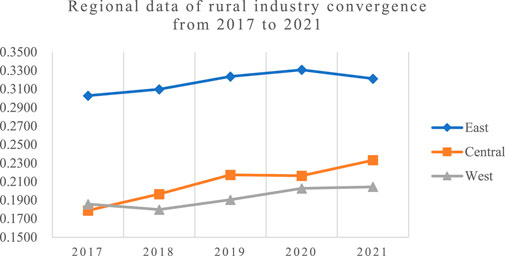
FIGURE 1. Comparison of the rural industrial convergence of different regions in China from 2017 to 2021.
By analyzing the scores of the sub dimensions of rural industrial convergence in Table 4, it is concluded that, the scores of each dimension from high to low are penetration of new technologies (0.0716), agricultural industrialization (0.0599), agricultural diversification (0.0543), farmers’ income increase and employment (0.0304) and urban-rural integration (0.0246) respectively. Among these 5 dimensions, the penetration of new technologies and agricultural industrialization revealed an upward trend from 2017 to 2021, while the other three dimensions tended to be stable, as shown in Figure 3.
4.1.2 Evaluation of rural ecological environment quality
The weight of the evaluation index system for the rural ecological environment quality is calculated by the EWM and listed in Table 3. The scores and rankings of rural ecological environment quality of 29 provinces in China from 2017 to 2021 are listed in Table 5. Nationwide, the rural ecological environment quality has not changed much, with an average score of 0.3222. The score of the central region (0.3351) is significantly better than that of the eastern (0.3175) and western regions (0.3173), and the gap between the eastern and western regions is small, as shown in Figure 4. The provincial data of rural ecological environment quality from 2017 to 2021 is displayed in Figure 5.
By analyzing the scores of the sub dimensions of rural ecological environment quality in Table 5, it is concluded that, the scores of each dimension from high to low are environmental.
Response (0.1431), environmental state (0.1082) and environmental pressure (0.0709) respectively. Among these 3 dimensions, environmental pressure and environmental state showed a slight downward trend from 2017 to 2021, and environmental response showed a fluctuating upward trend, as shown in Figure 6. This suggests that although the environmental pressure in rural areas of China is great, the humanistic response is increasing.
4.1.3 Evaluation of the coupling coordination between rural industrial convergence and ecological environment
The coupling coordination degree between rural industrial convergence and ecological environment in 2017–2021 are listed in Table 6. The mean value of the coupling coordination degree is 0.5206 nationwide, which means the two subsystems are Barely coordinated. Four provinces have achieved primary coordination, namely Shandong, Beijing, Jiangsu, and Zhejiang, all of which are developed coastal provinces in eastern China. Thirteen provinces have reached barely coordination, namely Heilongjiang, Tianjin, Xinjiang, Ningxia, Hebei, Hubei, Sichuan, Hainan, Jilin, Anhui, Hunan, Liaoning, and Inner Mongolia, most of which are provinces in central and Western China. The rest 12 provinces are on the verge of disorder, most of which are western provinces. The coupling coordination degree revealed a fluctuating upward trend from 2017 to 2021 in the whole country. Comparing the three major regions in China, eastern region has the highest coupling coordination (0.5551), followed by the central region (0.5110), and then the western region (0.4961). The gap between the East and the central and western regions is larger than that between the central and western regions, as shown in Figure 7.
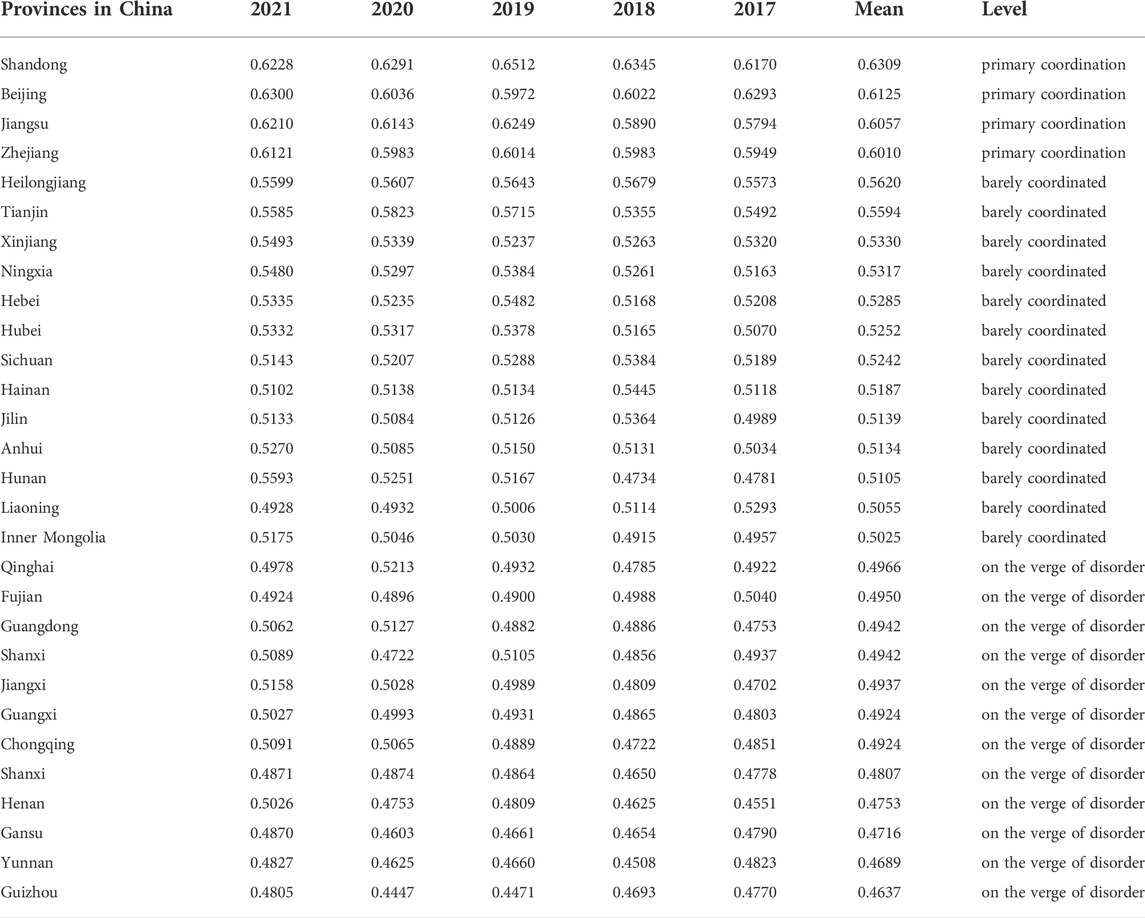
TABLE 6. Coupling coordination degree between rural industrial convergence and ecological environment of China in 2017–2021.
4.2 Prediction results from grey model GM (1, 1)
GM (1.1) model is used to predict the development of rural industrial convergence, the quality of ecological environment and the coupling coordination between the two. Due to the large amount of data calculated, only the prediction data of coupling coordination are shown, as listed in Table 7. The results of residual error test and posterior error test meet the accuracy requirements of mean relative error
This is mainly related to the urbanization rate of different regions. According to the 2021 statistical bulletin and public data released by each province of China, the urbanization rate of Shanghai, Beijing, Tianjin, Guangdong, Jiangsu, Liaoning, Zhejiang, and Chongqing has exceeded 70% in China, of which 7 provinces belong to the Eastern region and the rest one is a province-level municipality in the West. This means that the potential of rural industrial convergence in central and western provinces of China, especially in terms of agricultural industrialization and penetration of new technologies, will be greater in the future. The central and western provinces have a large jurisdiction and have the possibility to improve the intensification of the primary industry and the integrity of the supply chain by cultivating new agricultural business entities. To improve resource utilization efficiency and the quality of the ecological environment, circular agriculture, high-tech agriculture and the combination of planting and breeding can be encouraged. The eastern region has developed industrial economy, a large population, and a much smaller agricultural land. Agricultural multifunctionality can be developed by transforming the traditional planting industry into a combination of modern agriculture, agritourism and leisure agriculture. Deep processing of agricultural products and extension of the agricultural chain can be advocated to increase agricultural added value. Small-but-excellent agriculture is more likely to succeed by strengthening the interaction between rural and urban areas through urban agriculture and rural tourism, while reducing the environmental costs caused by non-intensive production.
Rural industrial convergence will increase steadily nationwide, from the value of 0.2251 in 2017 to 0.3732 in 2033, as shown in Figure 9. The speed is fastest in the central region, the second in the West and the slowest in the East. The central region will exceed the national average in 2027 and the eastern region in 2031. The gap between the West and the East is getting smaller and smaller. This implies that the coordination of rural industrial convergence and ecological environment may promote the development of rural industrial convergence. The quality of rural ecological environment will increase slowly nationwide after 2022, from the value of 0.3268 in 2017 to 0.3354 in 2033, as depicted in Figure 10. The environmental quality is the best in the central region, the second in the West and the worst in the East. In terms of the speed of environmental quality improvement, the West is the fastest, the central is the second, and the East is the slowest. This suggests that the quality of rural ecological environment may have a positive impact on the development of rural industrial convergence. The higher the quality of ecological environment and the faster the improvement speed, the more potential the development of industrial convergence.
5. Discussion
5.1 Establishment of the evaluation index system
This study is devoted to promote the understanding of the complex interaction between rural industrial convergence and ecological environment. An integrated approach is developed to explore the coupling coordination and prediction of rural industrial convergence and ecological environment. For the first step, a rational index system must be built to evaluate the two subsystems. In line with previous studies (Feng et al., 2016Li et al., 2017; Li and Ran, 2019; Chen et al., 2021; Tan and Yao, 2021), the indexes for rural industrial convergence are selected from two aspects: mode of rural industrial convergence and its socio-economic effects, which is furtherly subdivided into 5 dimensions of agricultural industrialization, agricultural diversification, penetration of new technologies, farmers’ income increase and employment, and Urban-rural integration. Compared with previous research, this study used more direct indicators and has a higher degree of consistency with the theoretical research. It obtains more than 27,000 pieces of raw data from several statistical yearbooks and the newly data from government documents, ensuring the reliability of the research. From the evaluation result, the score of “penetration of new technologies” and “agricultural industrialization” is higher than “agricultural diversification”. It is in accordance with the previous studies that agricultural industrialization is supported by new technology and rapid technological change (Lynne and Gary, 2010), which plays an important role in rural development (Urban, 1991). However, the agricultural industrialization has caused a problem in the sociology of agriculture and rural community welfare according to a study of 433 agriculture-dependent counties in the USA (Lyson and Welsh, 2005), hence the indexes of the socio-economic effects of rural industrial convergence are considered in this study. Farmers giving priority to traditional agriculture has hindered agricultural diversification into tourism in the EU (Hjalager, 1996), although demand for the different functions is significant from the case study of Spain (Kallas et al., 2010). Agricultural diversification is appealing to many countries since its benefits for increasing the farmers’ income and preservation of rural heritage, however it still faces a lot of challenges (Hernandez-Mogollon et al., 2011). The index system for rural ecological environment is constructed by the theoretical framework of PSR drawing on previous research. The development of rural society and economy has put great pressure on the rural ecological environment, which has been widely concerned by scholars (Dufumier, 1992; Liu and Li, 2020). Most studies on assessment of rural ecological environment use the AHP method to build the evaluation system, which is a subjective weighting method (Xu et al., 2021; Yu, 2021). This study employs EWM, an objective weighting method, to assign weight, which can reduce the subjective deviation caused by the human factors. The evaluation results show that the environmental response is the greatest contributor to the environmental quality, while environmental pressure is the smallest.
5.2 Relationship between rural industrial convergence and ecological environment
The relationship between industrial convergence and ecological environment is discussed by scholars. Although the conclusion is controversial, most studies believe that industrial integration is beneficial to ecological environment through energy efficiency improving (Dong et al., 2021a), green innovation (Dong et al., 2021b) and industrial structure upgrading (Yang and Wang, 2022). With the convergence of high-tech technologies, some traditional industries have developed into new eco-friendly industries (Zhou et al., 2022). What about the situation in rural areas? This aroused our research interest. With the development of urbanization, many economic and social problems have emerged in China’s rural areas, such as industrial decline, labor outflow, and left-behind children. In order to solve these problems, the Chinese government has formulated a national strategy of “the integration of rural primary, secondary and tertiary industries”. This means that farmers can not only engage in production, but also engage in agribusiness, such as the processing, circulation and online sales of agricultural products, rural tourism, etc., which will improve the farmers’ welfare and attract more entrepreneurs to rural areas. However, the primary development of industrial convergence and the lack of relevant legislation have caused negative impacts on the ecological environment in rural China. Therefore, it is urgent to explore the relationship between the two. Some scholars discussed the relationship between agricultural industrialization, agricultural diversification, rural tourism, and ecological environment (Hernandez-Mogollon et al., 2011; Davis and Langham, 1995) and found that interactions are complex. For example, while rural tourism can promote landscape protection and farmers’ awareness of environmental preservation, it is easy to damage the fragile rural ecosystem. An integrated approach needs to be developed for further research. Fortunately, CCD model is an approach to measure the interaction among multiple complex systems. By establishing a CCD model and a grey prediction model, the coupling coordination of rural industrial convergence and ecological environment is measured and predicted for 29 provinces in China. The results suggest that rural industrial convergence and ecological environment are barely coordinated nationwide in 2017–2021 and will get better in the next decade. The four developed provinces in the eastern coastal area have reached primary coordination. Economic and cultural development, application of agricultural technology, convergence of information technology, energy consumption structure and stock of natural resources are the reasons for regional differences. The high quality of ecological environment and its coordination with rural industrial convergence will contribute to rural social and economic development.
5.3 Limitations and future research
This study uses panel data from 29 provinces in China from 2017 to 2021. Since the development of agricultural diversification in China is just at the initial stage, the data collection is difficult, so the time frame of the study is relatively short. The construction of the indicator system follows the scientific principle as much as possible, but some indicators may inevitably be missed. With the development of China’s rural industrial convergence, relevant data will be more abundant, which provides a basis for exploring the relationship between rural industrial convergence and ecological environment in the future. The driving factors of the coupling coordination deserves further study.
6. Conclusion and suggestions
6.1 Conclusion
This paper constructs an integrated approach to explore the coupling and forecasting of rural industrial convergence and ecological environment. It first introduces a comprehensive evaluation index system of rural industrial convergence and ecological environment, and then uses EWM to determine the index weight and scoring of the two subsystems. Finally, a CCD model and a grey prediction model are developed to measure and predict the coupling coordination relationship. The finding suggests that:
1. The level of rural industrial convergence is on the rise nationwide from 2017 to 2021 and will remain the trend in the next 12 years. The speed is fastest in the central region, followed by the West and the slowest in the East. Among the 5 dimensions, penetration of new technologies and agricultural industrialization showed an upward trend and are better than agricultural diversification.
2. The rural ecological environment quality has not changed much from 2017 to 2021 nationwide and will increase slowly after 2022. Among these 3 dimensions, environmental pressure and environmental status showed a slight downward trend, and environmental response showed a fluctuating upward trend. This demonstrates that although the environmental pressure in rural areas of China is great, the humanistic response is increasing.
3. The rural industrial convergence and ecological environment are barely coordinated nationwide in 2017–2021. The coupling coordination showed a fluctuating upward trend on a national scale. Comparing the three major regions in China, eastern region has the highest coupling coordination, followed by the central region, and then the western region. The spatial differences are related to the level of economic and cultural development, application of agricultural technology, convergence of information technology, energy consumption structure and stock of natural resources.
4. The quality of rural ecological environment has a positive impact on the development of rural industrial convergence. The higher the quality of ecological environment and the faster the improvement speed, the more potential the development of industrial convergence. The coordination with ecological environment will promote the development rural industrial convergence.
6.2 Suggestions
To promote the coupling and coordination between rural industrial convergence and ecological environment, the following suggestions are put forward:
1) Develop agricultural science and technology, cultivate new varieties of agricultural products, introduce deep-processing and OEM enterprises of agricultural products, build characteristic industrial clusters and modern agricultural industrial parks, increase industrial concentration and scale effect, improve agricultural production capacity, and reduce the energy consumption. For example, in the West Coast new area of Qingdao City, Shandong Province, a new planting standard to cultivate blueberry clusters is adopted in order to achieve simultaneous ripening and long-time storage. The local blueberry processing plant can not only process blueberry juice and blueberry wine for farmers, but also provide packaging services. Therefore, it makes much easier for farmers to be only in charge of plantation and sales of blueberries and significantly increases profits of them. This practice is also well illustrated in the agricultural scientific research institution in Dezhou, Shandong Province. The research on the cultivation of a wide range of pepper varieties has increased the utilization rate of pepper raw materials by more than 15%. A combination of overall industrial chain development and technological innovation will ease the burden on natural environment imposed by agricultural development.
2) Promote the development of green agriculture and circular agriculture. Adhere to the combination of planting and breeding, make rational use of agricultural waste, and develop resource-saving agriculture. Reduce the use of chemical fertilizers and pesticides, facilitate large-scale breeding of livestock, poultry, and aquatic products, and seek solutions for serious problems in agricultural ecological environment. In the case of Urumqi County in Xinjiang Uygur Autonomous Region, the innovative “symbiosis of fish and vegetables” ecological cycle system has been introduced and an ecologically recycled system in which the excreta of fish in the water is natural organic fertilizer, absorbed by vegetables through the water circulation system, and then returned to the sedimentation and decomposition tank for recycling. Water conservation of the system can be very beneficial, reducing the use of water by 5–10% of traditional vegetable greenhouse. Xingqing District in Ningxia Hui Autonomous Region has developed the ecological agricultural system of “rice crab symbiosis”. It uses crabs to loosen the soil, catch insects, weed, and fertilize the field with crab feces, while provides a safe and cool growth environment for crabs in rice fields to realize a win-win situation of economy and ecology.
3) Integrate the rural cultural industry and rural tourism, expand the cultural, leisure, ecological and educational functions of agriculture, and form an industrial chain integrating feeling local culture, tasting local food, and enjoying rural scenery, to promote the improvement of rural ecological environment. Relying on its profound cultural heritage, Kaicheng town in Anhui Province integrates the brands of “hometown of calligraphy” and “hometown of poetry”, and relies on West Jiuhua Scenic Spot and surrounding rural scenery to promote the integration of cultural tourism and agricultural tourism. Sanbanqiao village in Hubei Province, is one of the production bases of Wachang rice, the “top ten famous rice in Hubei Province”. Relying on the advantages of the rice industry, it has cultivated colorful rice and built characteristic homestays, and held a research activity themed “the growth of a grain of rice”, forming an effective integration of characteristic industries and natural scenery.
4) Support all kinds of entities to build regional agricultural production service platforms, explore effective forms of agricultural socialized services, develop agricultural production services such as agricultural materials supply, outsourcing, threshing, drying, precooling, and storage, and adopt pollution prevention and control measures for emerging industries to carry out ecological restoration. Taidong Township in Heilongjiang Province is located at 47° north latitude, and the Songnen Plain runs through the whole territory. It has the unique advantage of developing organic food and dairy industry, and has organically transformed 15 ha of land that meets the conditions for scale operation, realizing the whole process trusteeship of agricultural production.
5) Strengthen the convergence of information technology and agriculture. Intelligent production management is of great significance to agricultural production, efficiency and safety. Rural areas can build smart agriculture platforms to realize real-time monitoring of agricultural information by using Internet of things, geographic information system and satellite remote sensing technology. The grape greenhouses in Miyun District of Beijing city are equipped with a variety of digital equipment, such as water and fertilizer integration system, plant protection machine and insect situation monitor. The water management of seedling cultivation used to depend on subjective judgment. Now, the smart system uses sprinkler irrigation equipment to carry out the drip fertigation according to the fertilizer demand and improves the quality of seedling cultivation. The system can monitor the irrigation volume in a timely manner, and stop irrigation when the irrigation reaches the maximum water holding capacity of the substrate. This practice not only improves the utilization rate of water and fertilizer, but also reduces the use of fertilizer and the damage to environmental pollution, and ultimately generates great economic and ecological benefits.
Data Availability Statement
The original contributions presented in the study are included in the article/supplementary material, further inquiries can be directed to the corresponding author.
Author contributions
Conceptualization, JiyZ; methodology, JiyZ; software, JiyZ; investigation, JinZ; resources, JinZ; data curation, JG; writing—original draft preparation, JG; writing—review and editing, JG; visualization, JG.
Acknowledgments
We gratefully acknowledge the financial support from Project Social Science Foundation Jiangsu Province (Grant No. 22GLB026).
Conflict of interest
The authors declare that the research was conducted in the absence of any commercial or financial relationships that could be construed as a potential conflict of interest.
Publisher’s note
All claims expressed in this article are solely those of the authors and do not necessarily represent those of their affiliated organizations, or those of the publisher, the editors and the reviewers. Any product that may be evaluated in this article, or claim that may be made by its manufacturer, is not guaranteed or endorsed by the publisher.
References
Akay, D., and Atak, M. (2007). Grey prediction with rolling mechanism for electricity demand forecasting of Turkey. Energy 32 (9), 1670–1675. doi:10.1016/j.energy.2006.11.014
Ariken, M., Zhang, F., Chan, N., and Kung, H. (2021). Coupling coordination analysis and spatio-temporal heterogeneity between urbanization and eco-environment along the Silk Road Economic Belt in China. Ecol. Indic. 121, 107014. doi:10.1016/j.ecolind.2020.107014
Bai, X. R., and Tang, J. C. (2010). Ecological security assessment of Tianjin by PSR model. Procedia Environ. Sci. 2, 881–887. doi:10.1016/j.proenv.2010.10.099
Boehlje, M., Schrader, L. F., and Royer, J. S., The industrialization of agriculture: Questions of coordination, 1998.
Bronfenbrenner, R. (1977). Industrial Organization in Japan. Richard E. Caves , masu uekusa. J. Political Econ. 85 (3), 653–655. doi:10.1086/260591
Cao, L. H., Hao, S. L., and Chen, N. X. (2010). Building and evaluation of the rural ecological environment index system. Res. Soil Water Conservation 17 (5), 1–4.
Chaniotakis, I. E. (2017). Food security and sustainability. Springer International Publishing.Innovative agri-food value chain financing in Greece
Chen, C. B., Li, S., and Tian, Y. (2021). Integration of the three industries in rural China and its provincial comparative analysis. Trans. Chin. Soc. Agric. Eng. 37 (2), 326–334.
Choi, H., and Sirakaya, E. (2006). Sustainability indicators for managing community tourism. Tour. Manag. 27 (6), 1274–1289. doi:10.1016/j.tourman.2005.05.018
Davies, E. T., and Gilbert, D. C. (1992). A case study of the development of farm tourism in Wales. Tour. Manag. 13 (1), 56–63. doi:10.1016/0261-5177(92)90033-4
Davis, C. G., and Langham, M. R. (1995). Agricultural industrialization and sustainable development: A global perspective. J. Agric. Appl. Econ. 27 (01), 21–34. doi:10.1017/s1074070800019556
Deschner, E. E., Cosse, J. D., and Sherlock, P. (2002). Analyzing environmental investment from the perspective of PSR model. Environ. Prot. 10 (3), 755–771.
Dong, F., Li, Y., Qin, C., and Sun, J. (2021b). How industrial convergence affects regional green development efficiency: A spatial conditional process analysis. J. Environ. Manag. 300, 113738. doi:10.1016/j.jenvman.2021.113738
Dong, F., Li, Y., Zhang, X., Zhu, J., and Zheng, L. (2021a). How does industrial convergence affect the energy efficiency of manufacturing in newly industrialized countries? Fresh evidence from China. J. Clean. Prod. 316, 128316. doi:10.1016/j.jclepro.2021.128316
Dosi, C., and Moretto, M. (1994). “Nonpoint source externalities and polluter's site quality standards under incomplete information,” in Non-point source pollution regulation: Issues and policy analysis (Kluwer Academic Publishers).
Dufumier, M. (1992). Environment and rural development. Tiers. Monde. 33 (130), 295–310. doi:10.3406/tiers.1992.4690
European Commission (1997). Green paper on the convergence of the telecommunications, media and information technology sectors, and the implications for regulation. Brussels: Information Society Project Office Eu.
Feng, W., Shi, R. J., Xia, H., and Gen, J. J. (2016). The evaluation index system of industrial convergence and development in rural areas. Hubei Agric. Sci. 55 (21), 5697–5701.
Ge, J., and Shudong, Z., Zhou Shudong Analysis of economic influencing factors of agricultural non-point source pollution-Based on the data of Jiangsu Province from 1978 to 2009. China's rural economy 2011, (5), 72–81.
Greenstein, S., and Khanna, T. (1997). “What does industry mean?,” in Competing in the age of digital convergence (Boston: President and Fellows of Harvard Press), 201–226. Yofee.
Grossman, G. M., and Krueger, A. B. (1995). Economic growth and the environment. Q. J. Econ. 110, 353–377.
Itamura, R., Ohata, H., Hashimoto, H., Morihara, T., Sun, N., et al. (2018). 'Sixth industrialization' of 'saijo' persimmon: Development of products for alleviating drunkenness. Acta Hortic. 1195, 161–168. doi:10.17660/actahortic.2018.1195.26
Hegarty, C., and Przezborska, L. (2005). Rural and agri‐tourism as a tool for reorganising rural areas in old and new member states-a comparison study of Ireland and Poland. Int. J. Tour. Res. 7 (2), 63–77. doi:10.1002/jtr.513
Hernandez-Mogollon, J. M., Campdn-Cerro, A. M., Leco-Berrocal, F., and Perez-Diaz, A. (2011). Agricultural diversification and the sustainability of agricultural systems: Possibilities for the development of agrotourism? Environ. Eng. Manag. J. 10 (12), 1911–1921. doi:10.30638/eemj.2011.255
Hjalager, A. M. (1996). Agricultural diversification into tourism: Evidence of a European Community development programme. Tour. Manag. 17 (2), 103–111. doi:10.1016/0261-5177(95)00113-1
Hou, J., Lu, J., and Yin, W. (2012). Study on the impact of farmers' management behavior on rural ecological environment. China's Popul. Resour. Environ. 22 (3), 26–31.
Hu, Y. C. (2020). A multivariate grey prediction model with grey relational analysis for bankruptcy prediction problems. Soft Comput. 24 (6), 4259–4268. doi:10.1007/s00500-019-04191-0
Huang, Z. (2019). Realize the construction of beautiful villages and high-quality development complement each other. Agric. Knowl. 9, 4.
Kallas, Z., Gomez-Limon, J. A., and Arriaza, M. (2010). Are citizens willing to pay for agricultural multifunctionality? Agric. Econ. 36 (3), 405–419. doi:10.1111/j.1574-0862.2007.00216.x
Kim, T-k. (2013). Harbin: The 10th northeast asia international forum on agricultural and rural development.Progress of globalization and agricultural and rural development strategy - six industrialization of agriculture
Knutson, R. D., and Cropp, R. A. (2013). Managing the supply chain through cooperatives and contract integration, 103–136.
Kumar, R., Singh, S., Bilga, P. S., Jatin, J., Singh, J., Singh, S., et al. (2021). Revealing the benefits of entropy weights method for multi-objective optimization in machining operations: A critical review. J. Mater. Res. Technol. 10 (9), 1471–1492. doi:10.1016/j.jmrt.2020.12.114
Lee, B., and Kim, D. K. (2009). Relative importance to tourism decision makers of indicators for sustainable rural tourism development in South Korea: Using AHP approach. J. Tour. 10 (2), 21–43.
Lewis, C. L, and D'Alessandro, S. (2019). Understanding why: Push-factors that drive rural tourism amongst senior travellers. Tour. Manag. Perspect., 32. doi:10.1016/j.tmp.2019.10057
Li, T. (2005). On rural environmental protection and its mechanism innovation. Guizhou Soc. Sci. (3), 25–28.
Li, X. L., and Ran, G. H. (2019). Research on the entrepreneurial effect of rural industrial convergence development: Empirical test based on the provincial heterogeneity. Statistics Inf. Forum 34 (3), 86–93.
Li, Y., Chen, J. H., and Chen, C. (2017). On the evaluation index system of agriculture convergence development and its application to beijing. Sci. Technol. Manag. Res. (4), 55–63.
Liang, L. T. (2013). Evaluation of rural ecological environment pressure based on catastrophe progression model. Resour. Environ. arid areas 27 (7), 46–51.
Liu, C., Wang, Q., Mizuochi, M., Wang, K., and Lin, Y. (2008). Human behavioral impact on nitrogen flow - a case study of the rural areas of the middle and lower reaches of the Changjiang River, China. Agric. Ecosyst. Environ. 125 (1-4), 84–92. doi:10.1016/j.agee.2007.12.001
Liu, Y., and Li, N. (2020). Analysis on the coupling development path of economy and ecological environment under the rural revitalization strategy. Fresenius Environ. Bull. 29 (12A), 11702–11709.
Liu, Y., and Huang, J. (2014). Rural domestic waste disposal: An empirical analysis in five provinces of China. China Agric. Econ. Rev. 6 (4), 558–573. doi:10.1108/caer-05-2013-0076
Lynne, Gary D. (2010). Agricultural industrialization: A metaeconomics look at the metaphors by which we live. Rev. Agric. Econ. 24 (2), 410–427. doi:10.1111/1467-9353.00106
Lyson, T. A., and Welsh, R. (2005). Agricultural industrialization, anticorporate farming laws, and rural community welfare. Environ. Plan. A 37 (8), 1479–1491. doi:10.1068/a37142
Malekinezhad, H., Sepehri, M., Pham, Q. B., Hosseini, S. Z., Meshram, S. G., Vojtek, M., et al. (2021). Application of entropy weighting method for urban flood hazard mapping. Acta Geophys. 69 (3), 841–854. doi:10.1007/s11600-021-00586-6
Marshall, A. (1992). The principles of economics. Hamilton, Canada: History of Economic Thought Books.
Mcgehee, N. G., and Kim, K. M. (2004). Motivation for agri-tourism entrepreneurship. J. Travel Res. 43 (2), 161–170. doi:10.1177/0047287504268245
Miller, G. (2001). The development of indicators for sustainable tourism: Results of a Delphi survey of tourism researchers: Results of a Delphi survey of tourism researchers. Tour. Manag. 22 (4), 351–362. doi:10.1016/s0261-5177(00)00067-4
Nagao, M., and Iwasaki, T. (2010). Significance of sixth-industrialization and its challenges for hokkaido. Region Econ. 7.
Nakano, K. (2014). The "sixth industrialization" for Japanese agricultural development. Ritsumeikan Econ. Rev. 3.
National Development and Reform Commission macro institute and the Department of agricultural economics research group (2016). Research on promoting the integration and development of rural primary, secondary and tertiary industries in China. Econ. Res. reference (4), 3–28.
Nicholas, N. P. (1975). Industry evolution and competence development: The imperatives of technological convergences. Int. J. Technol. Manag. 19 (7-8), 726.
Rhodes, V. J. (1993). Industrialization of agriculture: Discussion. Am. J. Agric. 75 (5), 1137–1139. Economics. doi:10.2307/1243439
Rothman, D. S. (1998). Environmental kuznets curves—real progress or passing the buck? A case for consumption based approaches. Ecol. Econ. 25 (2), 177–194. doi:10.1016/s0921-8009(97)00179-1
Sahal, D. (1985). Technological guideposts and innovation avenues. Res. Policy 14 (2), 61–82. doi:10.1016/0048-7333(85)90015-0
Shen, F., and Liu, Z. (2016). Logical reconstruction of good governance of rural environment - analysis Based on stakeholder theory. China's Popul. Resour. Environ. 26 (5), 32–38.
Shih, C. S., Hsu, Y. T., Yeh, J., and Lee, P. C. (2011). Grey number prediction using the grey modification model with progression technique. Appl. Math. Model. 35 (3), 1314–1321. doi:10.1016/j.apm.2010.09.008
Tan, Y. Z., and Yao, H. Q. (2021). Research on the impact of rural industrial integration on farmers’ income increase. Shanghai J. Econ. (9), 91–102.
Tang, J., Zhu, X., and Wang, T. (2017). Discussion on the green development of rural tourism in China. Environ. Prot. 45 (Z1), 62–64.
Thompson, C. S. (2004). Host produced rural tourism: Towa’s tokyo antenna shop. Annals of. Ann. Tour. Res. 31 (3), 580–600. doi:10.1016/j.annals.2003.11.004
Uekusa, M. (1989). The effect of innovations in information technology on corporate and industrial organisation in Japan. London: International Economic Association Series.
Urban, T. N. (1991). Agricultural industrialization: It's inevitable. Choices: The Magazine of food, farm, and resource issues. Agric. Appl. Econ. Assoc. 6 (4), 1–3.
Verdouw, C. N., Beulens, A. J. M., Trienekens, J., and Wolfert, J. (2010). Process modelling in demand-driven supply chains: A reference model for the fruit industry. Comput. Electron. Agric. 73 (2), 174–187. doi:10.1016/j.compag.2010.05.005
Wang, X. J., Wu, J. X., and Jiang, H. P. (2017). Dynamic assessment and trend prediction of rural eco-environmental quality in China. J. Nat. Resour. 32 (5), 864–876.
Xing, L., Xue, M., and Hu, M. (2019). Dynamic simulation and assessment of the coupling coordination degree of the economy–resource–environment system: Case of Wuhan City in China. J. Environ. Manag. 230 (JAN.15), 474–487. doi:10.1016/j.jenvman.2018.09.065
Xiong, x. (2012). Dual effects of rural tourism ecological environment and its correct response. Res. Tech. Econ. Manag. (11), 92–95.
Xu, W., Xu, F., Liu, Y., and Zhang, D. (2021). Assessment of rural ecological environment development in China's moderately developed areas: A case study of xinxiang, henan province. Environ. Monit. Assess. 193 (12), 801. doi:10.1007/s10661-021-09383-6
Yang, A., and Zhu, Y. (1999). Study on non-point source pollution of surface water environment. Prog. Environ. Sci. (7), 60–65.
Yang, x., and Li, H. (2019). Enterprises and environmental behavior: An empirical research on family entrepreneurs of farmhouses in Guangdong and Anhui province. Nankai Bus. Rev. 22 (1), 76–86.
Yang, Y., Wang, R., and Tan, J. (2021). Coupling coordination and prediction research of tourism industry development and ecological environment in China. Discrete Dyn. Nat. Soc., 6647781.
Yang, Z. H., and Wang, J. D. (2022). Quantifying the impacts of industrial convergence on air pollution: A quasi-experimental analysis of evidence from China's "triple play" reform. Environ. Sci. Pollut. Res. 29 (27), 40964–40983. doi:10.1007/s11356-021-18330-4
Yoffie, D. B. (1996). Competing in the age of digital convergence. Calif. Manag. Rev. 38 (4), 31–53. doi:10.2307/41165853
Yu, J. (2021). Research on the evaluation of ecological environment quality in rural tourism areas. Fresenius Environ. Bull. 30 (9), 10738–10747.
Zheng, Y. (2002). Impact of environmental pollution transfer on social economy. China rural. Econ. (2), 68–75.
Zhou, S. Y., Yang, X. Q., and Liao, Z. X. (2022). A study of industrial convergence in the context of digital economy based on scientific computing visualization. Mob. Inf. Syst., 1–12. doi:10.1155/2022/4025875
Zhu, Y. X., Tian, D. Z., and Yan, F. (2020). Effectiveness of entropy weight method in decision-making. Math. Problems Eng. 2020, 1–5. doi:10.1155/2020/3564835
Keywords: rural industrial convergence, rural ecological environment, coupling coordination degree model, grey prediction model, ecological enironment
Citation: Gu J, Zheng J and Zhang J (2022) Research on the coupling coordination and prediction of industrial convergence and ecological environment in rural of China. Front. Environ. Sci. 10:1014848. doi: 10.3389/fenvs.2022.1014848
Received: 09 August 2022; Accepted: 31 August 2022;
Published: 06 October 2022.
Edited by:
Faik Bilgili, Erciyes University, TurkeyReviewed by:
Luigi Aldieri, University of Salerno, ItalyZhang Anlu, Huazhong Agricultural University, China
Copyright © 2022 Gu, Zheng and Zhang. This is an open-access article distributed under the terms of the Creative Commons Attribution License (CC BY). The use, distribution or reproduction in other forums is permitted, provided the original author(s) and the copyright owner(s) are credited and that the original publication in this journal is cited, in accordance with accepted academic practice. No use, distribution or reproduction is permitted which does not comply with these terms.
*Correspondence: Jing Gu, Z3VqaW5nbmtAbmp4emMuZWR1LmNu
 Jing Gu
Jing Gu Jiyuan Zheng
Jiyuan Zheng
